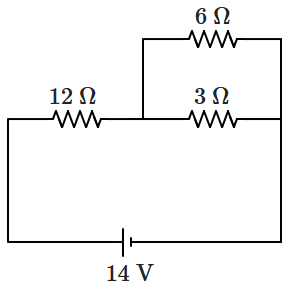In the circuit shown in the figure below, the current supplied by the battery is:

1. \(2~\text A\)
2. \(1~\text A\)
3. \(0.5~\text A\)
4. \(0.4~\text A\)

1. \(2~\text A\)
2. \(1~\text A\)
3. \(0.5~\text A\)
4. \(0.4~\text A\)
The equivalent resistance between points \(A\) and \(B\) in the circuit shown in the figure is:

| 1. | \(6R\) | 2. | \(4R\) |
| 3. | \(2R\) | 4. | \(R\) |
In the circuit shown in the figure below, if the potential difference between \(B\) and \(D\) is zero, then value of the unknown resistance \(X\) is:
| 1. | \(4~\Omega\) | 2. | \(2~\Omega\) |
| 3. | \(3~\Omega\) | 4. | EMF of a cell is required to find the value of \(X\) |
The figure below shows a network of currents. The current \(i\) will be:

1. \(3~\text{A}\)
2. \(13~\text{A}\)
3. \(23~\text{A}\)
4. \(-3~\text{A}\)
Eels are able to generate current with biological cells called electroplaques. The electroplaques in an eel are arranged in \(100\) rows, each row stretching horizontally along the body of the fish containing \(5000\) electroplaques. The arrangement is suggestively shown below. Each electroplaques has an emf of \(0.15\) V and internal resistance of \(0.25~\Omega\).
The water surrounding the eel completes a circuit between the head and its tail. If the water surrounding it has a resistance of \(500~\Omega\), the current an eel can produce in water is about:
| 1. | \(1.5\) A | 2. | \(3.0\) A |
| 3. | \(15\) A | 4. | \(30\) A |
A potentiometer wire has a length 4 m and resistance 8 Ω. The resistance that must be connected in series with the wire and an energy source of emf 2 V, so as to get a potential gradient 1 mV per cm of the wire is:
1. 32 Ω
2. 40 Ω
3. 44 Ω
4. 48 Ω
| 1. | \(2~\Omega\) | 2 | \(1~\Omega\) |
| 3. | \(0.5~\Omega\) | 4. | zero |
Power consumed in the given circuit is \(P_1.\) On interchanging the position of \(3~\Omega\) and \(12~\Omega\) resistances, the new power consumption is \(P_2.\) The ratio of \(\dfrac{P_2}{P_1}\) is:

| 1. | \(2\) | 2. | \(\dfrac 12\) |
| 3. | \(\dfrac 35\) | 4. | \(\dfrac 25\) |
In the case of a potentiometer, if the resistance of the rheostat is increased, then the balancing length for the same cell in the secondary circuit will:
1. increase
2. decrease
3. remain the same
4. increase or decrease
| 1. | \(10^{\circ}\text{C}\) | 2. | \(5^{\circ}\text{C}\) |
| 3. | \(20^{\circ}\text{C}\) | 4. | \(15^{\circ}\text{C}\) |








